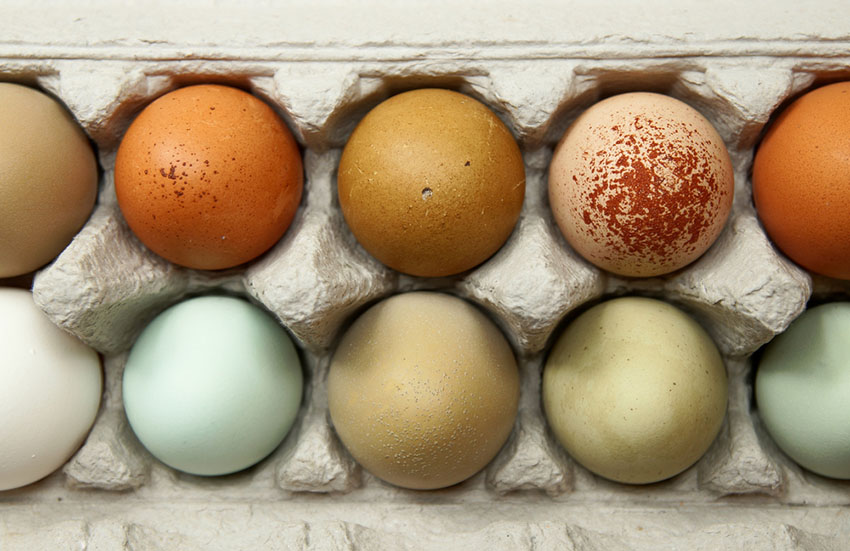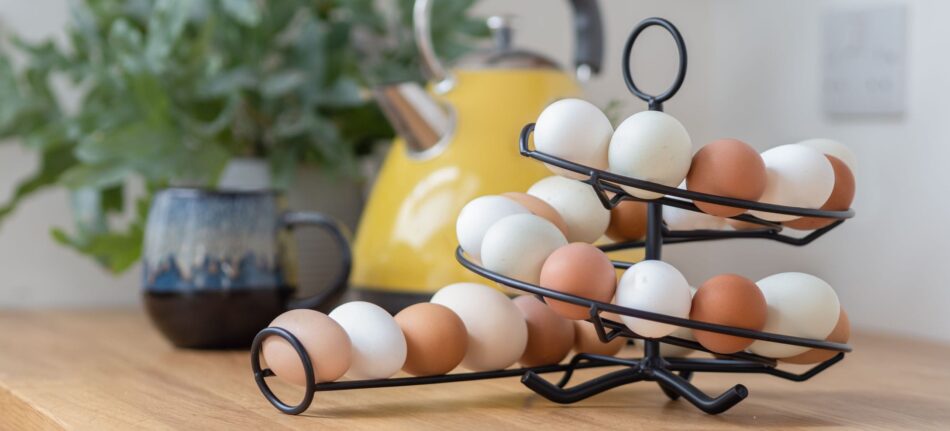Why Are Chicken Eggs Different Colours?

The ancestor of all chickens is the Red Junglefowl, Gallus gallus, a native of South-east Asia. All Junglefowl eggs have shells of a creamy white colour. And yet, as any chicken keeper knows, the eggs of domestic hens can vary widely.
Many years ago British chicken egg producers realised that shoppers favoured brown eggs, and turned their noses up at white ones. It was even said that brown eggs were more nutritious (which is not the case – all chicken eggs have the same nutritional value).
This tyranny of supermarket brown eggs continued until about 20 years ago, when a niche market was created for eggs from specific breeds. Chocolate browns, blues, and even the much-maligned whites, all began to appear on the shelves.
But for anyone familiar with backyard chickens, this was nothing new. Pearly whites from the Sussex and Leghorn, lovely blues from the Ameraucana and Cream Legbar, red-brown beauties from the Barnevelder and Welsummer and the dreamy greeny-blue of the Araucana and Favaucana are all in a day’s egg-collecting.
But why, given the fact that those ancestral chickens all laid creamy white eggs, do these different colours exist?
Egg Painting – the Natural Way
An egg takes around 26 hours to fully form inside a hen. Twenty of those hours are dedicated to toughening and colouring the egg shell. Layers of calcium carbonate provide the toughening – which is why hens need plenty of calcium in their diets – and the colouring is down to pigments. Calcium carbonate is naturally white, so any other colour has to be ‘painted on’, from the inside.
Breeders have created hundreds of chicken varieties over the centuries, and each of these has distinctive plumage and colouring. The pigments that give feathers colour sometimes go hand in hand with specific pigments for colouring egg shells too.
For example, the Ameraucana carries the blue pigment biliverdin, and this is painted onto the shell in the later stages of the egg’s development in the oviduct. Both the outside and inside of the shell have the same blue colour.
This is not the case with a standard brown egg. Crack one open and you’ll notice it’s white on the inside. The pigment responsible for brown colouring is protoporphyrin. This is present to a greater or lesser degree on the majority of chickens. Even eggs of a creamy colour have a hint of protoporphyrin in their shells. Hens carrying an excess of the pigment – such as the Delaware and Marans – produce fabulous chocolate brown eggs.
Many hens lay brown eggs dappled with darker brown spots and streaks. The Neera and Welsummer are good examples of this. The effect is causes by the egg turning as it makes its way through the oviduct, and it is a common feature in the eggs of many wild bird species. It is details like this that enable owners to recognise eggs from their individual birds (in a small flock, that is!)
When the two types of pigment – the blue and the brown – are mixed together, the result is a greenish blue or olive colour. If the brown pigment is light, as in the Favaucana and Araucana, the eggs are a soft greeny blue. With a darker brown in the mix, the olive colour is increased, as in the aptly named Olive Egger.
What Colour Are Your Chickens’ Earlobes?
It can come as a shock to learn that chickens have earlobes. Even more surprising to hear that these lobes give a clue to the colour of egg shells.
The earlobes are obvious, once they’ve been pointed out. Chickens have three types of ‘wattle’ – the red crest, the wobbly ones on the throat, and the ones on the side of the head, towards the back – the earlobes.
White earlobes are found on hens with white or otherwise pale plumage. These birds have relatively small amounts of pigment, hence the light feathers. The same rule applies to the eggs – no pigment, and hence white eggs. Meanwhile, hens with brown or reddish earlobes lay brown eggs, and ones with a creamy, pearly, shiny white earlobes lay blue eggs.
These days, ironically, it is the non-standard-brown eggs that command the higher prices in the shops. And yet once you get a clutch of golden-yoked, grass-fed, free range chicken eggs cooking side by side in a pan, you can’t tell which shell produced which egg. When it comes to chicken eggs, beauty is indeed in the eye of the beholder – and the earlobe of the chicken!
This entry was posted in Chickens
